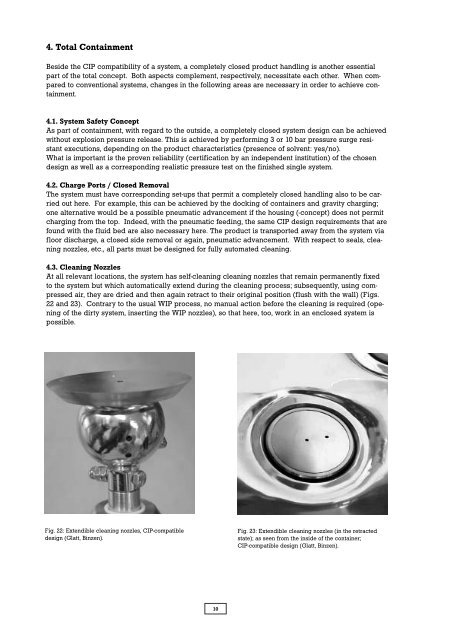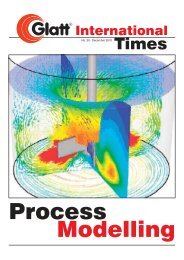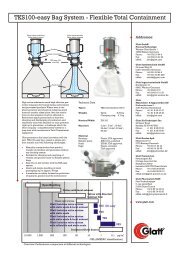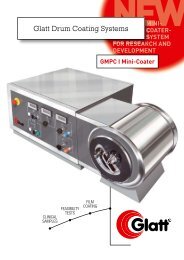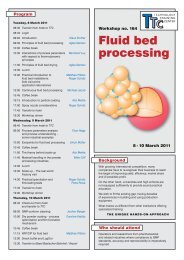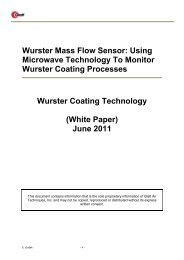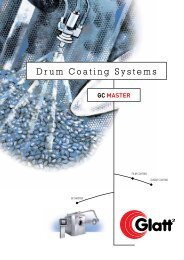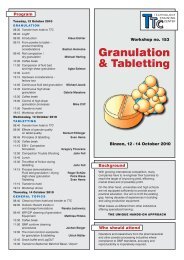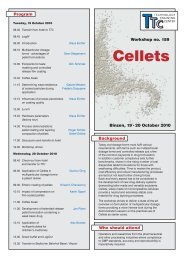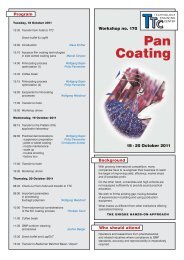Sonderdruck WIP / CIP - Glatt
Sonderdruck WIP / CIP - Glatt
Sonderdruck WIP / CIP - Glatt
Create successful ePaper yourself
Turn your PDF publications into a flip-book with our unique Google optimized e-Paper software.
4. Total Containment<br />
Beside the <strong>CIP</strong> compatibility of a system, a completely closed product handling is another essential<br />
part of the total concept. Both aspects complement, respectively, necessitate each other. When compared<br />
to conventional systems, changes in the following areas are necessary in order to achieve containment.<br />
4.1. System Safety Concept<br />
As part of containment, with regard to the outside, a completely closed system design can be achieved<br />
without explosion pressure release. This is achieved by performing 3 or 10 bar pressure surge resistant<br />
executions, depending on the product characteristics (presence of solvent: yes/no).<br />
What is important is the proven reliability (certification by an independent institution) of the chosen<br />
design as well as a corresponding realistic pressure test on the finished single system.<br />
4.2. Charge Ports / Closed Removal<br />
The system must have corresponding set-ups that permit a completely closed handling also to be carried<br />
out here. For example, this can be achieved by the docking of containers and gravity charging;<br />
one alternative would be a possible pneumatic advancement if the housing (-concept) does not permit<br />
charging from the top. Indeed, with the pneumatic feeding, the same <strong>CIP</strong> design requirements that are<br />
found with the fluid bed are also necessary here. The product is transported away from the system via<br />
floor discharge, a closed side removal or again, pneumatic advancement. With respect to seals, cleaning<br />
nozzles, etc., all parts must be designed for fully automated cleaning.<br />
4.3. Cleaning Nozzles<br />
At all relevant locations, the system has self-cleaning cleaning nozzles that remain permanently fixed<br />
to the system but which automatically extend during the cleaning process; subsequently, using compressed<br />
air, they are dried and then again retract to their original position (flush with the wall) (Figs.<br />
22 and 23). Contrary to the usual <strong>WIP</strong> process, no manual action before the cleaning is required (opening<br />
of the dirty system, inserting the <strong>WIP</strong> nozzles), so that here, too, work in an enclosed system is<br />
possible.<br />
Fig. 22: Extendible cleaning nozzles, <strong>CIP</strong>-compatible<br />
design (<strong>Glatt</strong>, Binzen).<br />
10<br />
Fig. 23: Extendible cleaning nozzles (in the retracted<br />
state); as seen from the inside of the container;<br />
<strong>CIP</strong>-compatible design (<strong>Glatt</strong>, Binzen).


